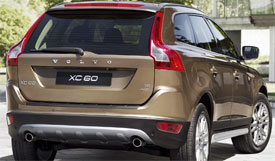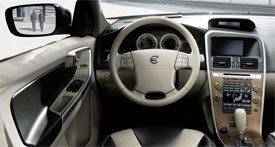2010 Volvo XC60
For more than a generation, Volvo has built its American reputation on two things: safety and its premium station wagons. Even when wagons fell out of favor at other brands, they remained an attraction for Volvo purists. But, some of those fans did defect to the Volvo XC90 Crossover. Now, with the all-new XC60, it’s possible that a lot more just might be tempted to follow suit.
The 2010 Volvo XC60 may be a late entry into the premium compact-to-midsize crossover race, but don’t expect this stylish and sporty utility to trail behind for too long.
The XC60 will compete directly with the BMW X3, the Acura RDX, and the Mercedes Benz GLK.
Styling hints of the XC70 and XC90, but from there the familiar Volvo DNA runs a little wild. The modified trapezoidal grille is flanked by dramatically flared headlamps.
The XC60’s wedge-like forward-leaning profile makes this crossover look like it’s ready to pounce. A muscular shoulder line, lower body cladding, and a coupe-like greenhouse all add to its athletic presence, as do the 18 or 19-inch wheels.
Further distinction comes from a well-sculpted back-end. But the most eye-catching cue is, no doubt, the exaggerated boomerang-like LED tail lamp design.
Offered currently as a single T6 all-wheel-drive model, the XC60 is moved by Volvo’s familiar 3.0-liter turbocharged inline-6, producing 281 horsepower and 295 pound-feet of torque. Max towing capacity is a reasonable 3,300 pounds.
 Power is managed by a six-speed automatic with manual mode which feeds Volvo’s latest Haldex 4 all-wheel drive system with Instant Traction torque transfer. For the more adventurous, Hill Descent Control is also available.
Power is managed by a six-speed automatic with manual mode which feeds Volvo’s latest Haldex 4 all-wheel drive system with Instant Traction torque transfer. For the more adventurous, Hill Descent Control is also available.
But this wouldn’t be a Volvo road test without a truly novel safety breakthrough. That would be Volvo’s City Safety System. City Safety is a low-speed rear collision avoidance system that utilizes an infrared laser in the rear view mirror to detect a stopped car ahead. City Safety will automatically apply the brakes at speeds up to 18 miles-per-hour to prevent a crash.
We don’t recommend you trying City Safety out just for grins like we did since it doesn’t activate until the last possible second. And stops are quite abrupt and really get your attention.
At the track, the XC60 also impressed us with its quickness. 0 to 60 in just 6.7 seconds and the quarter-mile in 15.2 seconds at 97 miles-per- hour. This crossover has a strong, smooth pull all the way up to the redline. Shifts, however, were not as quick as we would have liked them to be.
Sharing some chassis elements with the V70 and S80, suspension is front MacPherson strut/rear multi-link, with a three-mode active chassis option coming later. Aiding cornering now is an enhanced Dynamic Stability Control System, Roll Stability Control, and for towing maneuvers, new optional Trailer Stability Assist.
Maybe we expected too much, since this is a luxury car, but ride definitely rules over handling. The XC60 exhibits a top-heavy feel and reached its limits somewhat quickly.
Braking redeemed the XC60. Four-channel all-disc ABS with Brake Assist delivered average stops from 60 of a short 127 feet. They were solid and straight with minimal nose dive.
On everyday roads, the ride was soft and plush, perfect for Monday-through-Friday commutes. But with 9.1 inches of ground clearance, taking the XC60 off the pavement for a weekend adventure does not have to be a second thought.
 The interior of the five-passenger XC60 is a continuation of the clean and modern Scandinavian design we liked so much in the XC70 and C30. Gauges and controls are smartly laid-out and exude an artful sophistication.
The interior of the five-passenger XC60 is a continuation of the clean and modern Scandinavian design we liked so much in the XC70 and C30. Gauges and controls are smartly laid-out and exude an artful sophistication.
The XC60’s seats are well-contoured and supportive, featuring stitched seams and optional heat.
The slim, floating center stack design includes an available navigation screen that’s slightly angled toward the driver. It includes real-time traffic, and remote control.
There’s also a Rear Park Assist Camera packaged with the Nav system.
And not to be forgotten, our tester’s upgraded Dynaudio Premium Sound System with surround sound, for memorable listening enjoyment.
Other characteristic Volvo safety gear includes six airbags, anti-whiplash seats, and optional Lane Departure Warning.
The rear bench seat is fit for three, but it’s not the most spacious we’ve seen. Its 40/20/40 split, however, is family friendly, as are a pair of optional integrated child booster seats.
Cargo room is a generous 30.8 cubic feet with the seats up, and a very competitive 67.4 with the seats down.
Government Fuel Economy for this crossover is an underwhelming 16 city/22 highway on premium gas. We managed to get 20.6 miles-per-gallon in real-world driving.
Base pricing for the XC60 starts at $38,025. That’s less than a BMW X3, but more than the Acura RDX and the Mercedes-Benz GLK.
The eye-catching 2010 Volvo XC60 offers everything an upscale family could wish for - innovative safety, strong performance, true multi-purpose capabilities, and a comfortable, sophisticated cabin. For a company steeped in the tradition of the station wagon, the XC60 is a nice step up that doesn’t’ forget its roots.
Specifications
- Engine: 3.0-Liter Turbocharged Inline-6
- Horsepower: 281
- Torque: 295 Lb Feet
- 0-60 MPH: 6.7 Seconds
- 1/4 Mile: 15.2 Seconds @ 97 MPH
- 60-0 MPH: 127 Feet
- EPA: 16 MPG City/ 22 MPG Highway
- Mixed Loop: 20.6 MPG
2025 Volkswagen ID. Buzz
Volkswagen Brings Beetlemania Level Of Excitement To Minivan Segment
The duty of upholding Volkswagen’s heritage has most recently been delegated to small legacy car names like Golf and Jetta. But hold on! A much larger, totally modern take on VW’s classic microbus has just buzzed over the horizon— the all-electric ID. Buzz. It’s been at the top of our minds since we first saw the concept back in 2017. Well, it’s finally here, so let’s get our groove into drive!
This 2025 Volkswagen ID. Buzz has indeed created the most buzz around Volkswagen since the Beetle’s return to the U.S. in the late 1990s. We couldn’t drive it anywhere without drawing a crowd. No wonder, just about everyone has a VW Microbus story to tell, and seeing this reimagined version rolling down the street brings back all those memories.
VW really pulled it off as far as we’re concerned, as it looks great without appearing over the top. All the cues are here: Big VW logo front and center, lots of greenhouse including A-pillar windows and mini sliders for the second-row passengers, D-pillar air vents, and two-tone wheels. And while its appearance may be pure retro, its drivetrain is far from it, as the ID. Buzz is all-electric, and unlike the new Beetle, the Buzz does retain the original Microbus’ rear-drive architecture.
Powering those rear wheels is a 210-kW motor drawing juice from a 91-kWh battery for a range of 234 miles; 200-kW max charging will get you to 80% in about 26 minutes. Buyers can add another small 80-kW motor up front for 4motion all-wheel-drive and an increase of total output from 282 to 335 horsepower with a combined 512 lb-ft of torque. It uses the same battery, but range estimates drop just slightly to 231 miles. But while those numbers are modest, we also found them to be quite conservative, as we observed as many as 287 miles available in our all-wheel-drive tester’s gauge display and were on pace for 273 miles in our driving loop.
One throwback theme that may be a turnoff to some is that it’s quite a step up into the Buzz’s front seats, but there’s certainly a commanding view of the road once you climb in. Second row seating can be either a three-place bench or a pair of captain’s chairs, so there’s generous room for seven or six passengers. The captain’s chairs in our Pro S Plus offer good support and very easy access to the third row.
Lots of flexibility too with the option to simply fold the seats or remove them altogether.
With the sliding side doors and a wide opening rear hatch, there’s plenty of access for loading big sport utility amounts of cargo. Lots of flexibility too with the option to simply fold the seats or remove them altogether, and the ability to create a full-length flat floor with a rear cargo shelf that covers some handy removable storage bins. There’s 18.6 cubic-feet of space behind the third row, 75.5 behind the second, and a max of 145.5. That’s more than a Chevrolet Tahoe. For smaller items, there are lots of cubbies throughout the cabin, along with a standard Buzz Box that can be moved to multiple locations.
With a design that prioritizes retro form and modern function over aero efficiency, the 4motion equipped ID. Buzz earns a Fair efficiency rating, using 42-kWh of electricity per 100 miles, and we weren’t sure what to expect at our Mason Dixon test track.
What we found was great torque off the line and drama free launches to 60 in just 5.3 seconds. It was very stable at speed and power delivery stayed steady most of the way down the track until we reached about 90 mph, when it began to taper off just before we finished the quarter-mile in 14.0 seconds flat at 97 mph.
With 1,200-lbs. of battery weight nestled in its 127.5-inch wheelbase, the Buzz felt planted to the pavement through our handling course. There was quite a bit of body roll to deal with, but surprisingly little understeer. In panic braking runs, pedal response was inconsistent, feeling soft at times, pushing back hard at others; but through it all, results were quite good, stopping from 60 in an average of just 108 feet.
Three interior themes are available, this Dune is the brightest, featuring coastal inspired wood optic dash décor, “gray and clay” leatherette surfaces, and a high-mounted central 12.9-inch touchscreen. Pricing starts with a rear-wheel-drive Pro S at $61,545; this Pro S Plus begins at $65,045, add another $4,500 for 4motion, which brings a few extra features along with all-wheel drive.
Retro design with old-school VW charm, modern EV drivetrain, big SUV capacity merged with minivan flexibility; it all comes together in this 2025 Volkswagen ID. Buzz. It’s easily one of the coolest rides of the year and one that will likely keep Volkswagen dealers buzzing for years to come, and that’s something no other people and things mover can say.
Specifications
As Tested
- Motor Setup: Dual-Motor AWD
- Battery Size: 91-kWh
- Horsepower: 335
- Torque: 512 lb-ft
- EPA Range: 231 miles
- 0-60 mph: 5.3 seconds
- 1/4 Mile: 14.0 seconds at 97 mph
- Braking, 60-0: 108 feet
- MW Test Loop: ~ 273 miles













































